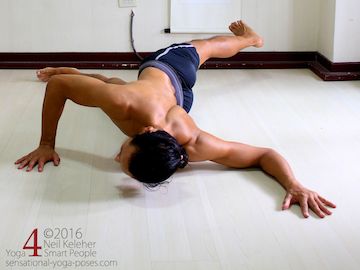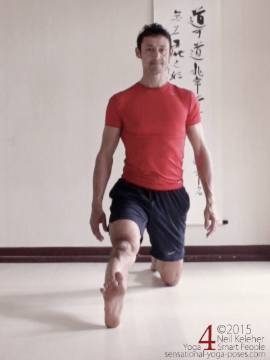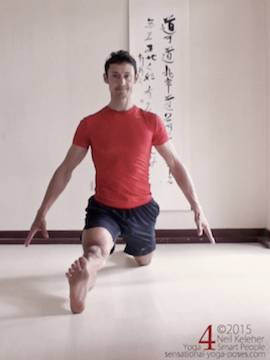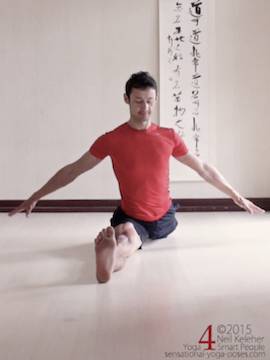Some stretching options
In this chest stretch (Bennittasana) I could use a variety of stretching methods. I could focus on relaxing the pectoralis major and passively stretch. Or I could focus on activating the back of the shoulder to actively stretch. Or I could use body weight to take me deeper into the stretch while resisting (a little) with the muscle being actively lengthened.
Active Stretching (and Having a Movement Intent)
First of all Jim's article focuses on what could be called an active stretching technique. (I've written an ebook that focuses on this technique). That's where you deliberately activate one set of muscles to stretch another set.
The focus isn't on the stretch (not necessarily) but on muscle activation. This stretching technique is actually very effective and I talk about how to practice it in the book Muscle Control for Better Flexibility.
An important key to this technique is learning how to activate the right muscles in the right combinations to take you deeper into a stretch.
What's also important in active stretching is not just muscle activation, but muscle activation with intent. As an example, you've seen people who can pop their pecs.
This is an example where muscles are activated without a movement intent. Instead the intent is to keep the arms stable. If you practice activating your pecs you may notice that when you pecs activate either your rear shoulder muscles or lats activate to keep the arms in place.
And so an important idea when using active stretching, rather than just activating a particular muscle, it helps to have a movement intent for the part of the body in question.
Muscle Activation With an Intended Movement
For that muscle activation to have a purpose within a pose it should have an associated movement. As an example, when I first started teaching yoga we often used to engage the quads. The theory was that this would help relax the hamstrings. Alas without a movement intent this instruction was probably not that helpful. In addition, the hamstrings work on the hips and the knees and so we need to focus on more than just the knees. We need to focus on the hip joints also.
What would be much more effective would be to engage the hip flexors to close the front of the hip joint. If the legs are the base then tilt the pelvis forwards. If the pelvis is the base then bring the leg(s) closer to he front of the body. And in either case, then use the quads to keep the knee straight.
In this case muscle activation has a purpose, to tilt the pelvis forwards while keeping the knee straight.
The Passive or Relaxed Stretching Method
In the passive stretching technique the focus is on relaxing the muscles being stretched.
Now should the whole body be totally relaxed in this type of stretching? No. Instead, focus on relaxing the target muscle and on keeping it relaxed as you lengthen it.
What can help in this technique is providing the part of my body being stretched with a stable foundation. As an example, when doing splits you can use your arms to support your body and to take some of your weight so that you can focus on relaxing my legs.
When doing relaxed stretching you can use gravity to provide the stretching force. That way the focus can be on gradually relaxing into the stretch.
Muscle Control and Relaxation
Learning to relax muscle is just as much a part of muscle control as contracting muscle, and relaxed or passive stretching is one way to practice deliberate relaxation.
You may find that after a relaxed stretch there is a delicious feeling of relaxation. It's like the buzz you get after holding a strong pose for a while, but slightly different.
Maybe the stretching helps to release "charge" that is trapped by muscle tissue that doesn't fully relax. This may be the equivalent of runners buzz. Though the stretching is very painful (in a masochistic kind of way), the pause afterwards is great because then you get to enjoy the after effects of the stretch. And that's something that you may find very helpful when doing relaxed stretching. Take time after each stretch to enjoy the after affects. It may make it easier to keep to your stretching schedule.
Deep Tissue Stretching
Relaxed stretching works on the connective tissue deep within the muscle. This is tissue that isn't stretched when the muscle is active.
Note that while this stretching technique hasn't hasn't resulted in huge flexibility gains for me, it has resulted in more body awareness and the ability to relax more. And like I said it feels good.
(A nice way to do a relaxed stretch for the shoulders is to hang from a chin up bar. Grip with all of your fingers. Slowly relax your shoulders to let your ribcage sink down. )
Contract and Release Passive Stretching
So what types of stretching techniques can help to increase flexiblity? One stretching method that you can used is to rhythmically contract and release the muscle being stretched.
This is handy in particular if you can't feel particular muscles. While doing a gravity assisted stretch, contract the muscle being stretched by resisting the stretch, then slowly and smoothly relax. Repeat.
You may find that you can gradually go deeper jsut from learning to relax. But at the same time you get the added bonus that you learn how to contract the muscle as it nears maximum length. And this can be handy because it means not only are you working on flexiblity, you are also working on range of motion control within the new flexibility range.
Muscle Assisted Passive Stretching
(Which is really Just Active Stretching with Another Name)
An alternative stretching technique is to do passive stretching and assist it with active stretching.
Holding a passive gravity assisted stretch you could activate the muscles that oppose the muscles being stretched. The activated muscles then work to take you deeper into the stretch.
Relax and repeat.
Resisted Stretching
or "Active Lengthening" Stretching Technique
One other type of stretching method is resisted stretching. This could also be called an active lengthening stretching technique. This is where the muscle being stretched is kept active but instead of shortening it lengthens.
As an example, in splits, you can lower down slowly and in control using your legs to resist the stretch. Your legs will slowly slide apart so that even as they widen the muscles being stretched are still active. In this case the muscle being stretched helps to provide it's own stability.
Resisted stretching can be used against gravity. But it can also be used against opposing muscle groups, or a combination of both.
Exploring Differet Stretching Techniques
If you are going to experiment with these stretching methods, focus on one technique per session so that you can get used to it.
Then once you've had experience with all of these techniques then you mix and match within a session or on any given day, try them all to see which one you need to focus on. You may find that ultimately your "stretches" end up being a mix of these methods. If it works, use it. After all, that is the real goal of all of these techniques and methods, whatever the name used, to help you realize more of your bodies potential.
One More Look at the Relaxed Stretching Method
In closing I should offer one other explanation for why I still use the passive "relaxed" stretching method.
I know of lots of people who can drop into the splits with ease, without having to contract opposing muscles. Amongst my own goals is to be able to lower into splits under control (which I can do) but also to be able to drop into them quickly.
And one way I am working towards this is to practice going into splits first under control, and then when I reach bottom, then I practice relaxing and then re-contracting.
Published: 2013 09 02






